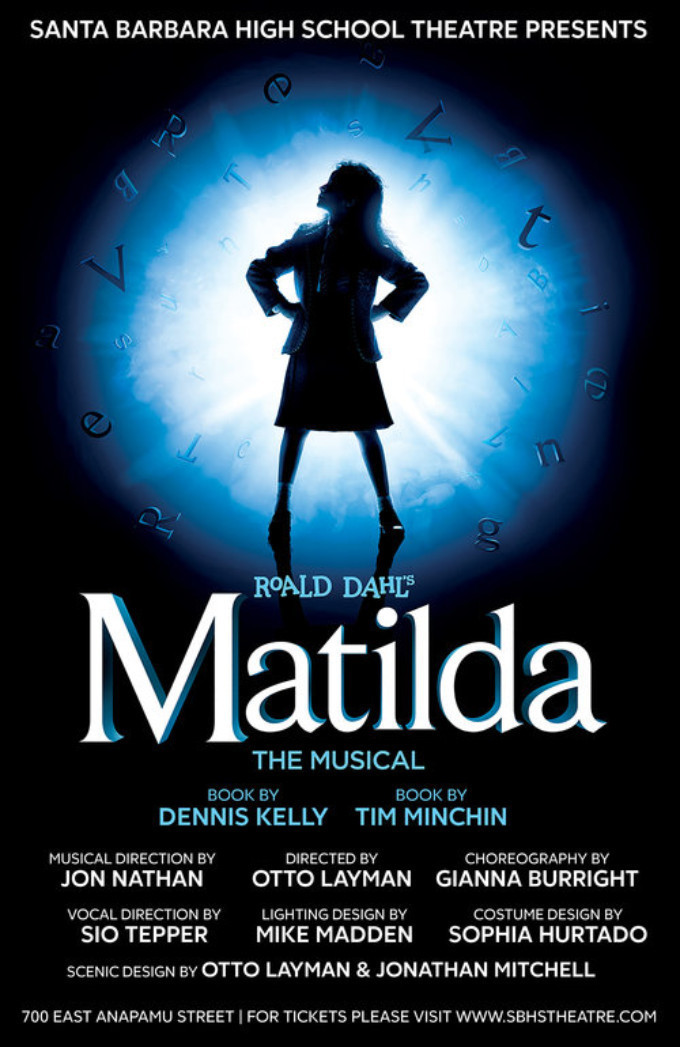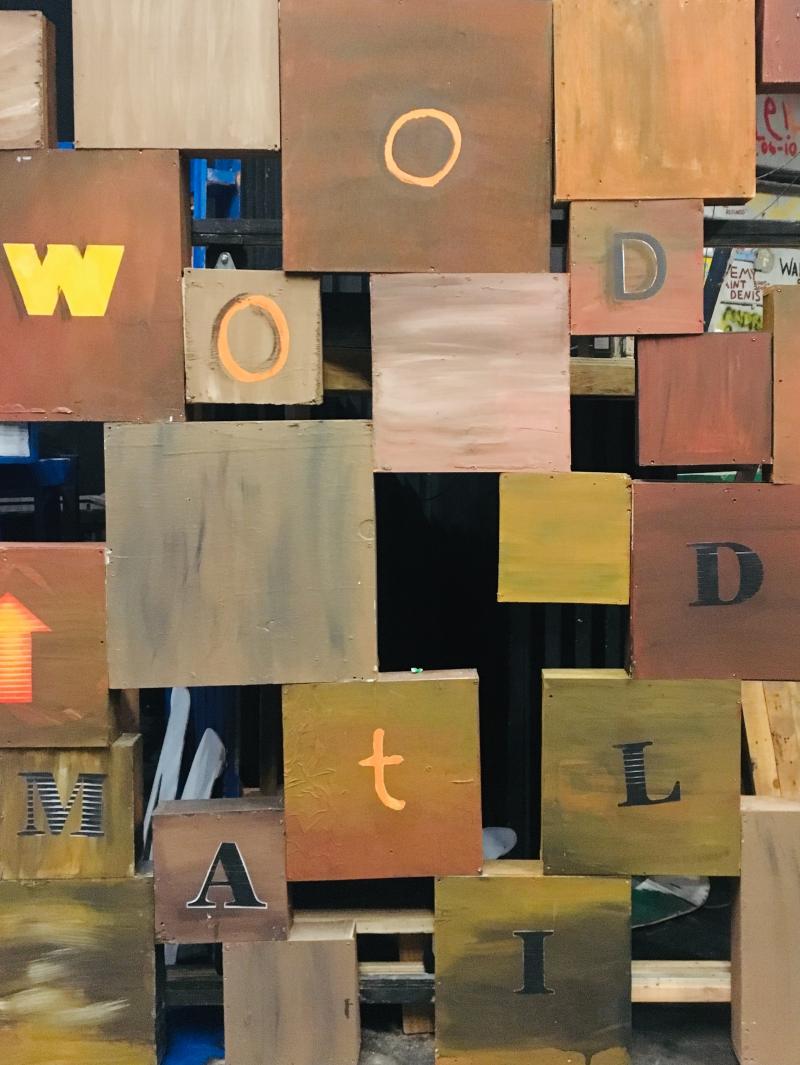BWW Preview: MATILDA: THE MUSICAL -- FOCUS ON DESIGN at Santa Barbara High School

High school offers many kids their first experience participating in the performing arts. In terms of theatre studies, that could be acting on a stage for the first time with a full cast, set, and orchestra; or working one of the many backstage jobs from fabricating props to helping the cast with costume changes in the wings. It's a pivotal time in the development of young theatre artists, one that lets students discover and explore the various cogs in the theatrical machine. These programs teach craft and instill passion, and provide a basic model for how theatrical productions run post-high school--whether you're on Broadway or at the Marjorie Luke.
This high-school-musical season, I got a sneak peek at Santa Barbara High's Matilda: The Musical, with a tour of the innovative set. It's a found-art, craftsy manifestation of the outlandish imagination of Matilda author Roald Dahl. If you didn't read Matilda as a child, get ready for an underdog story featuring an extraordinary girl who inspires her fellow classmates to rise against the oppression of their terrifying headmistress, "The Trunchbull".
Matilda opened last weekend, so you have another four chances, from May 9-12, to see the wonderland of words built on the SBHS stage.  Rotating set pieces and an upstage wall of alphabet blocks that slides in on floor tracks allow the space to transition into a multitude of locations. "I want to walk in the door and have some kind of 'wow'," says Otto Layman, director of Matilda and head of the SBHS theater program. Matilda uses the act of reading as a point of rebellion, so Layman and his scenic designer, Jonathan Mitchell, have built a space that heavily features lettering, words, and books, from a library nook made almost entirely of pages to the alphabet-block wall (the keen-eyed-viewer will be able to pick out words that the students have hidden in the seemingly random mix of letters). The set also includes Matilda's bedroom, the Wormwood family's living room, and Trunchbull's office. Each has an intricate complexion of details, such as the tchotchkes on the Wormwood's mantle and the elaborate paper sculptures in the library. "I don't think you can be too detailed, even if the audience can't see it," says Layman. "The actors will see it, and it allows them to be grounded in the space."
Rotating set pieces and an upstage wall of alphabet blocks that slides in on floor tracks allow the space to transition into a multitude of locations. "I want to walk in the door and have some kind of 'wow'," says Otto Layman, director of Matilda and head of the SBHS theater program. Matilda uses the act of reading as a point of rebellion, so Layman and his scenic designer, Jonathan Mitchell, have built a space that heavily features lettering, words, and books, from a library nook made almost entirely of pages to the alphabet-block wall (the keen-eyed-viewer will be able to pick out words that the students have hidden in the seemingly random mix of letters). The set also includes Matilda's bedroom, the Wormwood family's living room, and Trunchbull's office. Each has an intricate complexion of details, such as the tchotchkes on the Wormwood's mantle and the elaborate paper sculptures in the library. "I don't think you can be too detailed, even if the audience can't see it," says Layman. "The actors will see it, and it allows them to be grounded in the space."
These set structures are devised by Layman and Mitchell, but the students are the craftspeople of the individual elements. The cast and crew, along with the kids in the daily theatre classes, take ownership of much of the process. "We built something like 700 boxes," Layman says of the backdrop wall. "We had a letterbox factory... We teach them how to work, and then we show them--for instance, the alphabet block--and say 'this is what we need; go make this.'" Students with particular skill or experience with theatrical systems are tasked with problem solving design issues. It was a stagecraft student who devised the magic behind the chalkboard scene--one of the most important climax points in the show.

Layman's practice of teaching theatrical process and creating productions is inspired in many ways by his experience working with Robert Weiss, who was the artistic director at Ensemble Theater before Jonathan Fox. "I wanted to write for the theater," Layman says, "and I figured I couldn't write for it if I didn't know how it worked...Robert Weiss was a great teacher because he was a great artist. Everything was about detail, always detail." Another custom encouraged by Weiss is Layman's deep involvement with the design of the set. Every theatre space has its limitations, but Layman and Mitchell view them as challenges rather than problems. A director who knows the capabilities of the space and the requirements of the set can more adeptly structure efficient and artistic movement of performers and set pieces. The challenges at SBHS includes orchestra placement in lieu of an orchestra pit, and how to best use the minimal wing space. Packed with desks and students, the backstage work that the audience doesn't (shouldn't) see involves its own choreography. "These last two weeks," Layman says of the rehearsals leading up to opening, "are really about solving our traffic problems. It's like the 405 back there."
Layman and Mitchell have worked together on the SBHS shows for the last five years, and Layman has worked with the lighting designer, Mike Madden, for almost 15 years. Madden lives in Oregon, now, but drives down the coast to light Layman's shows. This continued partnership with a solid team allows the designers and director to model an efficient workflow for getting a show on its feet.
Matilda is a show about students finding their voices and exploring their power, though Layman's final wisdom to instill in the cast and production team is the importance of the ensemble over the individual actors. "It's what we push all the time," Layman says. "It's not about the them, it's about the production. I never have a curtain call with individual bows. That hierarchy is toxic, and I want to teach them that the ensemble, like the set, is a character."
Don't miss Matilda: The Musical at SBHS!
Thursday, May 9th at 10am
Friday, May 10th at 7pm
Saturday, May 11 at 2 & 7pm
Sunday, May 12 at 2pm
Comments

Videos

